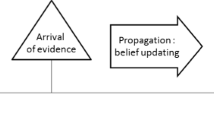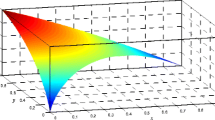Abstract
In the last few years, evidence theory, also known as Dempster-Shafer theory or belief functions theory, have received growing attention in many fields such as artificial intelligence, computer vision, telecommunications and networks, robotics, and finance. This is due to the fact that imperfect information permeates the real-world applications, and as a result, it must be incorporated into any information system that aims to provide a complete and accurate model of the real world. Although, it is in an early stage of development relative to classical probability theory, evidence theory has proved to be particularly useful to represent and reason with imperfect information in a wide range of real-world applications. In such cases, evidence theory provides a flexible framework for handling and mining uncertainty and imprecision as well as combining evidence obtained from multiple sources and modeling the conflict between them. The purpose of this paper is threefold. First, it introduces the basics of the belief functions theory with emphasis on the transferable belief model. Second, it provides a practical case study to show how the belief functions theory was used in a real network application, thereby providing guidelines for how the evidence theory may be used in telecommunications and networks. Lastly, it surveys and discusses a number of examples of applications of the evidence theory in telecommunications and network technologies.





Similar content being viewed by others
Notes
The power set of any set S, written \(\mathcal {P}(S)\) or 2S, is the set of all subsets of S, including the empty set and S itself.
Under closed world assumption m(∅)=0. Under open world assumption, m(∅) may be positive. For the difference between the open and closed world assumptions, see Smets [37].
References
Ahmed M, Huang X, Sharma D, Shutao L (2012) Wireless sensor network internal attacker identification with multiple evidence by Dempster-Shafer theory. In: Xiang Y, Stojmenovic I, Apduhan B, Wang G, Nakano K, Zomaya A (eds) In: Algorithms and architectures for parallel processing. Lecture notes in computer science, vol 7440. Springer, Berlin Heidelberg, pp 255–263
Ahmed MR, Huang X, Sharma D (2012) A novel misbehavior evaluation with Dempster-Shafer theory in wireless sensor networks In: Proceedings of the 13th ACM international symposium on mobile Ad Hoc networking and computing, MobiHoc ’12. ACM, New York, pp 259–260
Aregui A, Deneoux T (2008) Constructing consonant belief functions from sample data using confidence sets of pignistic probabilities. Int J Approx Reason 49(3):575–594
Barnett J (1991) Calculating Dempster-Shafer plausibility. IEEE Trans Pattern Anal Mach Intell 13(6):599–602
Bi Y, Nugent C, Liao J (2012) An evidential framework for associating sensors to activities for activity recognition in smart homes. In: Greco S, Bouchon-Meunier B, Coletti G, Fedrizzi M, Matarazzo B, Yager R (eds) In: Advances in computational intelligence, communications in computer and information science, vol 299. Springer, Berlin Heidelberg, pp 564–574
Chen T, Venkataramanan V (2005) Dempster-Shafer theory for intrusion detection in ad hoc networks. IEEE Internet Comput 9(6):35–41
Chen Y, Terzis A (2011) On the implications of the log-normal path loss model: an efficient method to deploy and move sensor motes In: Proceedings of the 9th ACM conference on embedded networked sensor systems, SenSys ’11. ACM, New York, pp 26–39
Chintalapudi K, Dhariwal A, Govindan R, Sukhatme G (2004) Ad hoc localization using ranging and sectoring In: INFOCOM 2004. 23rd AnnualJoint conference of the IEEE computer and communications societies, vol 4, pp 2662–2672
Diaz-Ramirez A, Tafoya LA, Atempa JA, Mejia-Alvarez P (2012) Wireless sensor networks and fusion information methods for forest fire detection. Procedia Tech 3 69–79. The 2012 Iberoamerican conference on electronics engineering and computer science
Duarte MF, Hu YH (2004) Vehicle classification in distributed sensor networks. J Parallel Distrib Comput 64:826–838
Dubois D, Prade H (1992) On the combination of evidence in various mathematical frameworks. In: Flamm J, Luisi T (eds) Reliability data collection and analysis, Eurocourses, vol 3. Springer, Netherlands, pp 213–241
Elouedi Z, Mellouli K, Smets P (2004) Assessing sensor reliability for multisensor data fusion within the transferable belief model. IEEE Trans Syst Man Cybern 34(1):782–787
Elouedi Z, Mellouli K, Smets P (2004) Assessing sensor reliability for multisensor data fusion within the transferable belief model. IEEE Trans Syst Man Cybern 34(1):782–787
Farah MB, Mercier D, Lefvre E, Delmotte F (2013) A high-level application using belief functions for exchanging and managing uncertain events on the road in vehicular ad hoc networks. Ann Telecommun: 1–15
Gao H, Zhu J, Li C (2008) The analysis of uncertainty of network security risk assessment using Dempster-Shafer theory. In: 12th International conference on computer supported cooperative work in design, 2008. CSCWD 2008. pp 754–759
Guo L, Cukic B, Singh H (2003) Predicting fault prone modules by the Dempster-Shafer belief networks. In: 18th IEEE international conference on automated software engineering, 2003. Proceedings, pp 249–252
Kolgomorov A (1950) Foundations of the theory of probability. Chelsea Publishing Company
Li B, Zhu Y, Rong Li X (2002) Fault-tolerant interval estimation fusion by Dempster-Shafer theory. In: Proceedings of the 15th international conference on information fusion, 2002. vol 2, pp 1605–1612 vol 2
Li W, Joshi A (2009) Outlier detection in ad hoc networks using Dempster-Shafer theory In: Proceedings of the 2009 10th international conference on mobile data management: systems, services and middleware, MDM ’09. IEEE Computer Society, Washington, pp 112–121
Matheus A, Stelte B (2012) Evidence theory for reputation-based trust in wireless sensor networks In: Proceedings of the 3rd international conference on computing for geospatial research and applications, COM.Geo ’12. ACM, New York, pp 38:1–38:2
Mourad F, Snoussi H, Abdallah F, Richard C (2011) A robust localization algorithm for mobile sensors using belief functions. IEEE Trans Veh Tech 60(4):1799–1811
Panigrahi S, Kundu A, Sural S, Majumdar A (2007) Use of Dempster-Shafer theory and bayesian inferencing for fraud detection in mobile communication networks. In: Pieprzyk J, Ghodosi H, Dawson E (eds) Information security and privacy. Lecture notes in computer science, vol 4586. Springer, Berlin Heidelberg, pp 446–460
Panigrahi S, Kundu A, Sural S, Majumdar AK (2009) Credit card fraud detection: a fusion approach using Dempster-Shafer theory and bayesian learning. Inf Fusion 10(4):354–363
Pietropaoli B, Dominici M, Weis F (2012) Belief inference with timed evidence: methodology and application using sensors in smart home. In: The 2nd international conference on belief functions, pp 409–416
Raggad BG (2005) Intrusion detection and response system generator: using transferred belief model In: Proceedings of the 4th WSEAS international conference on applications of electrical engineering, AEE’05. World Scientific and Engineering Academy and Society (WSEAS), Stevens Point, pp 210– 216
Sebbak F, Benhammadi F, Chibani A, Amirat Y, Mokhtari A (2013) Dempster-Shafer theory-based human activity recognition in smart home environments. Ann Telecommun:1–14
Senouci M, Mellouk A, Oukhellou L, Aissani A (2011) Uncertainty-aware sensor network deployment. In: IEEE global telecommunications Conf. GLOBECOM’11. Houston, pp 1–5
Senouci M, Mellouk A, Oukhellou L, Aissani A (2012) Efficient uncertainty-aware deployment algorithms for wireless sensor networks In: Wireless communications and networking conference (WCNC), 2012. IEEE, Paris, pp 2163–2167
Senouci M, Mellouk A, Oukhellou L, Aissani A (2012) An evidence-based sensor coverage model. IEEE Commun Lett 16(9):1462–1465
Senouci M, Mellouk A, Oukhellou L, Aissani A (2012) Using the belief functions theory to deploy static wireless sensor networks. In: Denoeux T, Masson MH (eds) In: Belief functions: theory and applications, advances in intelligent and soft computing, vol 164. Springer, Berlin/Heidelberg, pp 425–432
Senouci M, Mellouk A, Oukhellou L, Aitssadi NFusion-based WSN surveillance applications deployment: an evidence-based approach. Work-in-Progress
Sentz K, Ferson S (2002) Combination of evidence in Dempster-Shafer theory. Technical Report SAND 2002-0835. Sandia National Laboratories
Shafer G (1976) A mathematical theory of evidence. Princeton University Press
Siaterlis C, Maglaris B (2004) Towards multisensor data fusion for DOS detection In: Proceedings of the 2004 ACM symposium on applied computing, SAC ’04. ACM, New York, pp 439–446
Simon C, Weber P (2006) Bayesian networks implementation of the Dempster-Shafer theory to model reliability uncertainty. In: The 1st international conference on availability, reliability and security, 2006. ARES 2006. p 6
Simon C, Weber P, Evsukoff A (2008) Bayesian networks inference algorithm to implement dempster shafer theory in reliability analysis. Reliab Eng Syst Saf 93(7):950–963
Smets P (1988). In: Mamdani DP, Smets EH, Prade H (eds) In: Non-standard logics for automated reasoning. Academic Press, London, pp 253–286
Smets P (1990) The combination of evidence in the transferable belief model. IEEE Pattern Anal Mach Intell 12:447–458
Smets P (1997) Imperfect information: imprecision and uncertainty. In: Motro A, Smets P (eds) In: uncertainty management in information systems. Springer, US., pp 225–254
Smets P (2005) Decision making in the TBM: the necessity of the pignistic transformation. Int J Approx Reason 38:133–147
Smets P, Kennes R (1994) The transferable belief model. Artif Intell 66:191–234
Tian C, Zou S, Wang W, Cheng S (2007). In: Dimitrakos T, Martinelli F, Ryan P, Schneider S (eds) In: formal aspects in security and trust. Lecture notes in computer science, vol 4691. Springer, Berlin Heidelberg, pp 270–284
Ricquebourg V, Delafosse M, Delahoche L, Marhic B, Jolly-Desodt A, Menga D (2007) Fault detection by combining redundant sensors: a conflict approach within the TBM framework. In: University S (ed) In: COGIS 2007, COGnitive systems with interactive sensors. California
Wahab OA, Otrok H, Mourad A (2014) A cooperative watchdog model based on Dempster-Shafer for detecting misbehaving vehicles. Comput Commun. doi:10.1016/j.comcom.2013.12.005
Wang B (2010) Coverage control in sensor networks. Springer, New York
Wickramrathne T, Premaratne K, Murthiy M (2013) Convergence analysis of consensus belief functions within asynchronous ad hoc fusion networks. In: IEEE international conference on acoustics, speech and signal processing (ICASSP), 2013. pp 3612– 3616
Wu H (2003) Sensor fusion for context-aware computing using Dempster-Shafer theory. Ph.D. thesis, Robotics Institute, Carnegie Mellon University, Pittsburgh
Xie Y, Phoha VV (2001) Web user clustering from access log using belief function. In: Proceedings of the 1st international conference on knowledge capture, K-CAP ’01. ACM, New York, pp 202–208
Yager RR, Kacprzyk J, Fedrizzi M (eds) (1994) Advances in the Dempster-Shafer theory of evidence. Wiley, New York
Zadeh L (1965) Fuzzy sets. Inf Control 8:338–353
Zadeh L (1978) Fuzzy sets as a basis for theory of possibility. Fuzzy Sets Syst 1:3–28
Zervas E, Mpimpoudis A, Anagnostopoulos C, Sekkas O, Hadjiefthymiades S (2011) Multisensor data fusion for fire detection. Inf Fusion 12(3):150–159. Special issueon information fusion in future generation communication environments
Zhao Z, Hu H, Ahn GJ, Wu R (2012) Risk-aware mitigation for manet routing attacks. IEEE Trans Dependable Secure Comput 9(2):250–260
Zhuge JW, Wang BDW, Chen TY, Zhi-Yuan Y, Zou SW (2006) A network anomaly detector based on the d-s evidence theory. J Softw 17(3)
Author information
Authors and Affiliations
Corresponding author
Rights and permissions
About this article
Cite this article
Senouci, M.R., Mellouk, A., Senouci, M.A. et al. Belief functions in telecommunications and network technologies: an overview. Ann. Telecommun. 69, 135–145 (2014). https://doi.org/10.1007/s12243-014-0428-5
Published:
Issue Date:
DOI: https://doi.org/10.1007/s12243-014-0428-5




